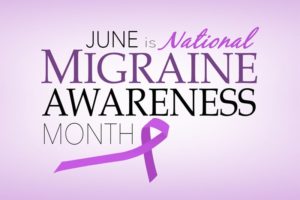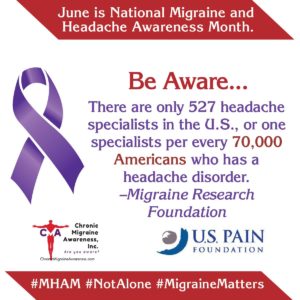June is National Migraine & Headache Awareness Month (MHAM), an opportunity to raise awareness about migraine and other headache diseases. Migraine impacts forty million people in the United States, one billion people across the globe, and is recognized as the #2 cause of disability worldwide. Currently, about 16 million people with migraines in the U.S. are undiagnosed. Approximately 400,000 Americans experience cluster headaches, recognized as one of the most painful diseases a person can have.
The word “headache” is a broad term used to describe pain in the scalp, head and neck. There are many different types of headaches. They may be primary conditions such as tension headaches, migraines and cluster headaches, or they may occur due to underlying health conditions.
Headaches are very common, most people experience them to some degree during their life.
“Headache disorders are amongst the world’s most debilitating conditions globally,” says Susan Broner, M.D., medical director of the Weill Cornell Medicine Headache Program. “In fact, migraine itself is the second most disabling condition in the world in terms of years lost to disability. And if you look at populations of people under 50, it’s the first most disabling condition yet many people go undiagnosed and untreated.”
Severe or recurring headaches of any type can significantly impact daily life. Learning about them can help you communicate your concerns more clearly to your primary care provider.
Tension Headaches:
Tension headaches are the most common type of headache. People often experience occasional tension headaches and don’t seek medical care. However, if you have tension headaches 15 days per month or more, you should consult with your primary care provider.
Causes of Tension Headaches
These headaches are caused by tense muscles around the head and neck, often due to stress, anxiety or depression. Tension headaches may also be triggered by:
- Alcohol
- Caffeine or caffeine withdrawal
- Dental problems such as frequently grinding your teeth or clenching your jaw
- Eyestrain
- Keeping your head in one position for a long time
- Not getting enough sleep
Treating and Preventing Tension Headaches
Occasional tension headaches can often be prevented by:
- Exercising regularly
- Getting enough sleep
- Maintaining good posture while seated and taking breaks from sitting
- Managing daily stress
Chronic tension-type headaches are typically treated with stress reduction techniques such as meditation or cognitive behavioral therapy and biofeedback.
Over-the-counter pain medications (e.g., ibuprofen or acetaminophen) may be used to decrease pain. Muscle relaxers or prescription antidepressants may also be recommended in some cases.
Migraine Headaches:
Migraines are a severe, recurring type of headache that is often debilitating. About 12% of people in the United States have migraines and they are more common in women.
Causes of Migraines
The exact cause of migraines is unknown. But researchers believe that genetics plays a part. Having certain medical conditions may increase your risk of developing migraines, including:
- Anxiety
- Bipolar disorder
- Depression
- Epilepsy
- Sleep disorders
Migraines can be triggered by several factors. Caffeine is one of the more common triggers people encounter. Caffeine is always a mystery to people because many people find that it helps a headache,
There is currently no cure for migraine, but we are in a renaissance of new treatments, therapies, and approaches to managing the disease. If you have been struggling in silence, now is the time to speak up, educate yourself, and seek care. You might just change your life for the better.
During the Covid pandemic, there was a significant rise in telemedicine. According to a survey by the Headache and Migraine Policy Forum and MigraineAgain, 78% of migraine and headache patients used telemedicine after the start of the pandemic, in comparison to just 22% before the pandemic. This trend was ushering in a new era of care, where patients could interact with health professionals from the convenience and comfort of their homes. The survey also revealed that there had been a nearly 70% rise in the number of migraine attacks during the pandemic and 84% of people had more stress managing their disease.
On the treatment front, there are new options for patients to explore. “Migraine and headache patients now have more options due to a wave of innovation in acute and preventive care,” noted Dr. William Young, Professor of Neurology, Thomas Jefferson University and Medical Advisor for the Coalition for Headache and Migraine Patients. “These include CGRP monoclonal antibodies, gepants, lasmiditan, and several neuromodulation devices.”
It is so much easier to for many humans to feel since they don’t see anything a migraine or general headache is not so bad but when you experience you may feel different when seeing those people with that symptom. Headache specialists play a vital role in migraine advocacy and awareness efforts. The symptoms of migraine often cause patients living with the disease to withdraw from their daily lives.. Others may refrain from identifying themselves as a migraine patient, due to stigma surrounding the disease and a lack of compassion surrounding its symptoms. For these patients and so many more, we as healthcare professionals must continue to advocate on their behalf.
A disease awareness month plays a vital role to raise public knowledge, address stigma and build a stronger community of patient advocates.

